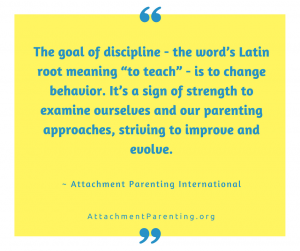 From the Attachment Parenting perspective, positive discipline embodies the “golden rule” of parenting — in other words, treat children the way you would want to be treated if you were the child.
From the Attachment Parenting perspective, positive discipline embodies the “golden rule” of parenting — in other words, treat children the way you would want to be treated if you were the child.
Positive discipline is an overarching concept based in the understanding that when a child is treated respectfully within loving, age-appropriate boundaries, he will develop a conscience guided by his own internal discipline and empathy for others.
Positive discipline is rooted in a secure, trusting, and loving relationship between parent and child. With a strong foundation of trust, positive discipline incorporates empathic and respectful strategies that over time will strengthen the connection between parent and child, while harsh or overly punitive discipline weakens the connection.
Using shame, humiliation, guilt, manipulation, coercion, or physical forms of discipline can interfere with the connection between parent and child. Physical forms of discipline have been shown to lead to an increased risk of future antisocial behavior, including crime and substance abuse. Children raised with the fear of being hurt learn to behave positively, because they are in sight of their parents or another authority figure. They may fear punishment, or they may fear a loss of parental love and affection. Although physical discipline and fear may change behavior in the short term, it will not have the desired effects in the long term.
At the heart of positive discipline is a secure attachment relationship with your child. Gordon Neufeld and Gabor Maté write in their book, Hold On to Your Kids, that “for purposes of childrearing, the crowning achievement of a working attachment is to instill in a child the desire to be good” — in other words, they say when a child feels secure in his attachment to his mother and father, he will want to be good, and he will be a child who is easy to parent.
And this is what countless parents who’ve raised children with positive discipline have experienced.
There are many positive discipline strategies, such as redirection and problem-solving and emotion-coaching, but it may be easier to illustrate given a specific situation:
Let’s say you come downstairs to find your toddler drawing a picture on the wall.
You may feel like yelling, or hitting, but instead, try stepping outside of your anger and see the situation through your child’s eyes. She doesn’t recognize that the wall is not the appropriate place to draw. Then, you can begin problem-solving.
Positive discipline doesn’t mean letting your child draw on the wall, but rather setting a firm boundary keeping his development in mind. Perhaps, keep the crayons in a place where he has to ask to get into them. Or only giving drawing an option when you are able to be in the same room. Or, better yet, color with him!
Your child can help you clean up the wall. You can show your child where she can draw. You can tell her that you feel angry but don’t make it her responsibility to make you feel happy. See her part, but also your part, in how the situation came to be, and then model to her how to work together to solve the problem and be more proactive for next time. Consistency is also important.
These is just a few of the options for this specific situation, and parents who use positive discipline all have their own approach to setting boundaries. The more you practice positive discipline, the more natural it feels.
If you’re looking for ideas to get started, here are a few favorite books on positive discipline:








